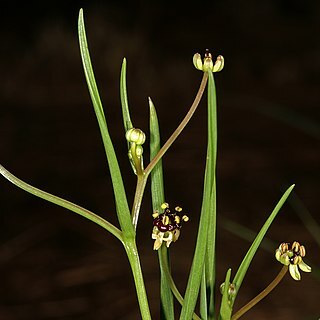Slender glaucous plants 5-40 cm high. Corm ovoid with a knee-shaped horizontal tuber of the previous year attached to it. Stems flexuose, leafless in lower part but covered by a tubular bract. Leaves ascending, somewhat fleshy, lamina slightly folded, emerging from a long tubular leaf sheath, linear, 5-15 cm long, 5 mm broad, apex acute. Flowers forming a loose apical raceme with the upper axillary leaves reduced; pedicels erect in flower, looped downwards in fruit, 2.5 cm long. Perianth deciduous, patent or reflexed, depending on stage of development, pale mauve and green with oblong, apiculate segments 3.5 mm long, 1.5 mm broad. Stamens opposite the segments, with very short filaments which have an orbicular swelling in the middle, anthers versatile. Ovary ovoid with many ovules; style about as long as the ovary, semi-persistent, stimga minute, apical. Capsule globose to cylindrical, up to 20 mm long, 15 mm broad but usually smaller, with grey-brown thin walls. Seeds oblong-rounded, 3 by 4 mm, minutely papillate, brownish, raphe ending in a small apiculus at the opposite end of the funicle.
More
A small herb. It grows 20 cm high. It has an underground stem about 20 cm long and this has 2 oval corms at the end. The plant keeps growing from year to year. The leaves are narrow. They are in a zigzag pattern in 2 distinct rows. The lower leaves are 9-11 cm long by 5 mm wide. They become smaller higher up. The flowers are 50 mm long. They are pale red to brown. They occur singly in the axils of the upper leaves.
Gregarious geophyte, up to 400 mm tall. Corm ovoid with a knee-shaped, horizontal tuber of previous year attached to it. Filaments with a thick bulge in middle. Style long, with a small, apical stigma. Flowers pale mauve and green.
It is a subtropical plant. It grows in hot arid areas. It grows in areas with a marked dry season. The dry season can be 6-11 months. It grows in dry sandy soils. It grows between 45-1,530 m above sea level. It can grow in arid places.
More
Growing in small colonies in open, sandy habitats.

